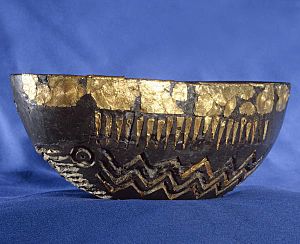Caergwrle Bowl facts for kids
The Caergwrle Bowl is a very special object from the Middle Bronze Age. It was made around 1300 BC. This unique bowl was crafted from shale, tin, and gold. It was discovered in Caergwrle, a place in Wales. Many people think the bowl looks like a boat. Its gold decorations might show oars and waves. The round gold shapes could be suns or shields. You can also see two 'eyes' at each end of the boat.
Contents
What Does the Caergwrle Bowl Mean?
Many experts believe the Caergwrle Bowl shows a special 'solar boat'. This is a mythical boat that carries the sun across the sky. Other similar objects have been found. These include small gold boats from Nors in Denmark. There is also the later Broighter gold boat from Ireland.
The Caergwrle Bowl is also linked to the Nebra sky disc from Germany. This older disc is also thought to show a solar boat. The gold cape from Mold was found near Caergwrle. It is from the same time as the Nebra sky disc.
Some gold necklaces called Gold lunulae also look like solar boats. These are from the early Bronze Age Bell Beaker culture. Examples have been found in Wales. The zig-zag patterns on the Caergwrle Bowl look like waves. These patterns are also seen on some other Bell Beaker bowls.
Eyes on Boats and Gold Bowls
Boats with 'eyes' on them were also known in ancient Greece. In old Greek stories and art, the 'Sun's vessel' was often a gold bowl or cup. It was said to sail across the sea.
Gold cups from the Early Bronze Age in Britain and Ireland are similar to those from Greece. Later, large pots called cauldrons from the Late Bronze Age also show these links.
Gold bowls from Eberswalde in Germany also have round sun symbols. These symbols are like simple calendars. They are the same as those on the Berlin Gold Hat. These symbols are thought to show the Metonic cycle. This is a way to track the sun and moon.
Discovery and Restoration
The Caergwrle Bowl was found in 1823. A worker was digging a drain in a field. This field was below Caergwrle Castle. The bowl was not complete when found.
It was given to the National Museum Wales in 1912. Then it was sent to the British Museum for repair. At first, it was put back together with wax and glue. Later, the bowl was rebuilt again. The first repair was not strong enough.
See also
- Battersea Cauldron
- Hochdorf Chieftain's Grave


